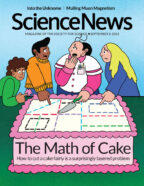This post was originally published on this site
Piece of cake
For decades, researchers have studied the cake-cutting problem, which explores how to fairly divide resources, Stephen Ornes reported in “A fair slice?” (SN: 9/9/23, p. 14).
The last-diminisher method is one way to divide a cake among a group, Ornes wrote. One person cuts a slice they deem is a fair share. Each remaining person then gets a turn to either trim the slice or pass. The last person to trim gets the piece and exits the game. The trimmings are then recombined with the remaining cake, and the process restarts.
Reader Robert Lavelle tried this method to split a sandwich among 13 students. It worked smoothly until one student wanted a smaller piece than her fair share. Those who left the game before her got pieces equal to each other, as did those who left after. But the first group ended up with smaller pieces.
As the story covers, this method is not envy-free: Those who exit early may covet pieces cut later. But there is a solution, says Steven Brams, a game theorist and political scientist at New York University. “Let all the players not make full cuts but notches where they would make cuts. If a person indicates she wants only a smaller piece, cut this piece off for her. Then run the procedure again, without her piece, for the other players,” he says.
Clarification
“Extravagance of early galaxies” stated that about 372,000 years after the Big Bang, during the “cosmic dark ages,” hydrogen formed and filled the cosmos with an opaque gas (SN: 8/12/23, p. 18). It would have been clearer to write that hydrogen made the cosmos transparent to certain wavelengths of light while opaque to others. Eventually, after the first stars and galaxies formed, hydrogen atoms lost their electrons, lifting the veil that blocked certain wavelengths.
Corrections
“Extravagance of early galaxies” incorrectly defined the cosmic dark ages. That period is so named because no stars, hence no starlight, existed then, not because hydrogen gas clouded the cosmos. The story also mistakenly noted that protons, electrons and neutrons combined to form that hydrogen. Only protons and electrons did.
Due to an editing error, “Semaglutide may benefit the heart” stated that 15 kilograms is about 11 pounds (SN: 9/23/23, p. 8). It is about 33 pounds.

